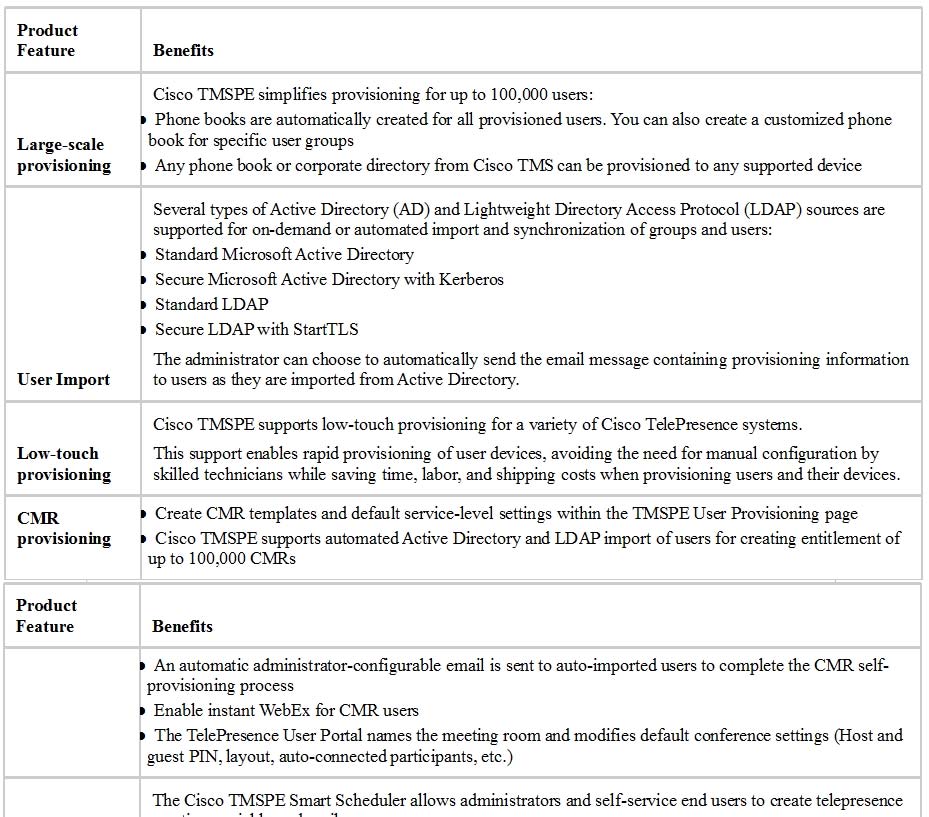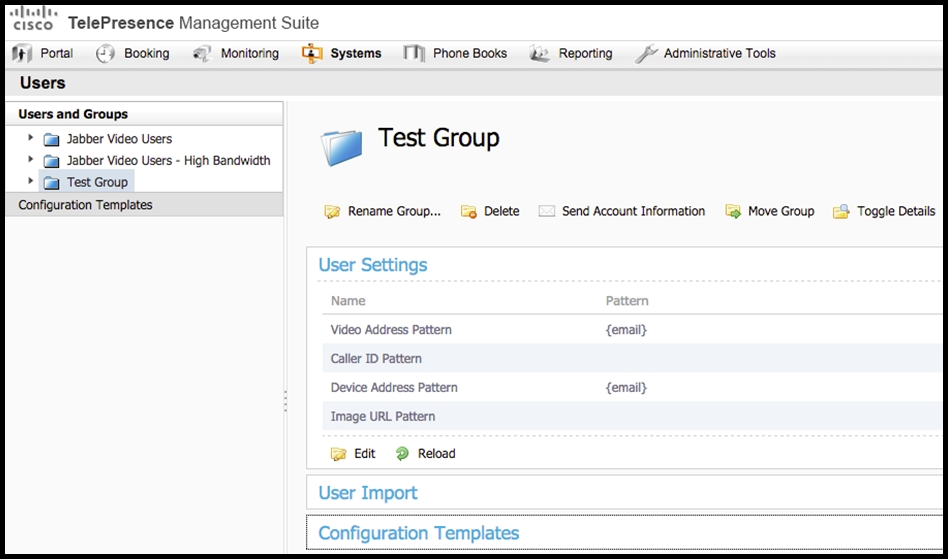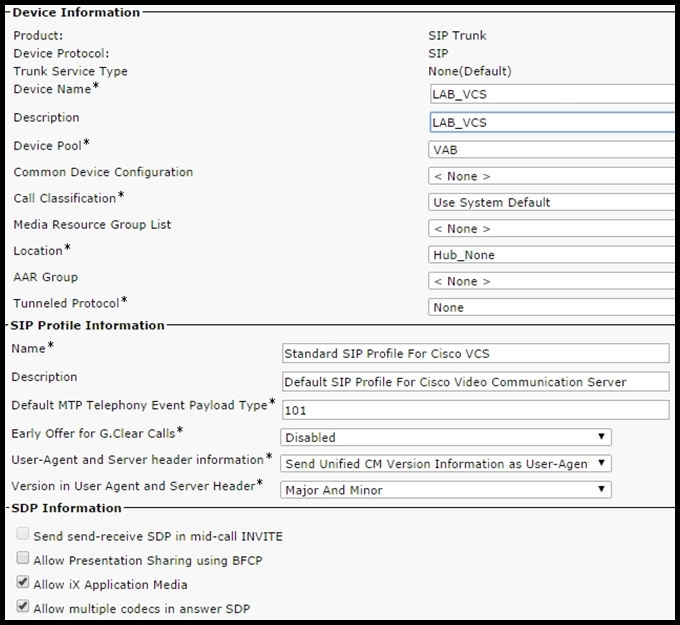Cisco® 210-065 Exam Practice Questions (P. 1)
- Full Access (341 questions)
- Six months of Premium Access
- Access to one million comments
- Seamless ChatGPT Integration
- Ability to download PDF files
- Anki Flashcard files for revision
- No Captcha & No AdSense
- Advanced Exam Configuration
Question #1
Which four features are provided by Cisco TelePresence Management Suite? (Choose four.)
- AScheduling of video conference calls
- BBuilt-in-bridge functionality for multiparty video conferences
- CSIP-H.323 protocol interworking
- DCentralized management of conference resources
- ESMTP email event notification
- FEndpoint configuration backup and restore
- GCisco TelePresence endpoint automated redundancy
- HAutomated resource optimization
Correct Answer:
ADEF
Reference: http://www.cisco.com/c/en/us/products/collateral/conferencing/telepresence-management-suite-tms/data_sheet_c78-707529.html
Features of Cisco TMS include:
✑ Centralized management of all conferences, impromptu and scheduled, in real time
✑ Flexible scheduling tools designed to meet the needs of basic users for quick conference creation, including integration with Microsoft Exchange for scheduling through Outlook clients, and to provide advanced conference booking options for sophisticated users
✑ Robust and flexible phone book management that supports synchronization with a wide range of directories, including external sources for easy contact management
✑ A selection of ready-to-use reports and support for the creation of fully customizable reports to answer specific business questions
ADEF
Reference: http://www.cisco.com/c/en/us/products/collateral/conferencing/telepresence-management-suite-tms/data_sheet_c78-707529.html
Features of Cisco TMS include:
✑ Centralized management of all conferences, impromptu and scheduled, in real time
✑ Flexible scheduling tools designed to meet the needs of basic users for quick conference creation, including integration with Microsoft Exchange for scheduling through Outlook clients, and to provide advanced conference booking options for sophisticated users
✑ Robust and flexible phone book management that supports synchronization with a wide range of directories, including external sources for easy contact management
✑ A selection of ready-to-use reports and support for the creation of fully customizable reports to answer specific business questions
send
light_mode
delete
Question #2
Which three features are supported by Cisco TMSPE? (Choose three.)
- ASimplified provisioning
- BLDAP user import
- CScheduling via Microsoft Outlook
- DFindMe
- EJabber for Windows
- FAutomatic endpoint upgrades
Correct Answer:
ABD
Reference: http://www.cisco.com/c/en/us/products/collateral/conferencing/telepresence-management-suite-tms/data_sheet_c78-707901.html
Table 1. Features and Benefits of Cisco TMSPE

ABD
Reference: http://www.cisco.com/c/en/us/products/collateral/conferencing/telepresence-management-suite-tms/data_sheet_c78-707901.html
Table 1. Features and Benefits of Cisco TMSPE

send
light_mode
delete
Question #3
Management wants to modify Cisco TMS to allow users to configure the call behavior with their associated devices and dial from a single ID. Which feature needs to be enabled and configured?
- ASmart Scheduler
- BLow-touch Provisioning
- CFindMe
- DCMR Provisioning
Correct Answer:
C
Reference: http://www.cisco.com/c/en/us/products/collateral/conferencing/telepresence-management-suite-tms/data_sheet_c78-707901.html
With FindMe, you can be reached on any device using a single ID
You can define your locations and specify which endpoints are available to you in those locations
You can also specify which endpoints (video and audio only) should ring when someone calls your FindMe ID
FindMe also allows you to specify additional devices to be called if the default devices are busy or not answered
Administrators can configure account IDs for each user, set up location and device templates, and choose whether to add new devices to FindMe automatically on provisioning
You can create FindMe accounts to define forwarding rules for groups such as support desks
The FindMe portal is located on the Cisco TMS Server, where you can log on with your Active Directory credentials
You can access your Cisco TMSPE account settings, see your username and video address (Session Initiation Protocol Uniform Resource Locator [SIP URI]), and change your provisioning password.
C
Reference: http://www.cisco.com/c/en/us/products/collateral/conferencing/telepresence-management-suite-tms/data_sheet_c78-707901.html
With FindMe, you can be reached on any device using a single ID
You can define your locations and specify which endpoints are available to you in those locations
You can also specify which endpoints (video and audio only) should ring when someone calls your FindMe ID
FindMe also allows you to specify additional devices to be called if the default devices are busy or not answered
Administrators can configure account IDs for each user, set up location and device templates, and choose whether to add new devices to FindMe automatically on provisioning
You can create FindMe accounts to define forwarding rules for groups such as support desks
The FindMe portal is located on the Cisco TMS Server, where you can log on with your Active Directory credentials
You can access your Cisco TMSPE account settings, see your username and video address (Session Initiation Protocol Uniform Resource Locator [SIP URI]), and change your provisioning password.
send
light_mode
delete
Question #4
Refer to the exhibit.

Which configuration item shown in the exhibit should be used to assign the internal and external video communication server address for this group of users?

Which configuration item shown in the exhibit should be used to assign the internal and external video communication server address for this group of users?
- AUser Settings > Video Address pattern
- BAdministrative Tools > User Settings
- CConfiguration Template > Edit Template
- DUser Import > Configuration
Correct Answer:
C
http://www.cisco.com/c/dam/en/us/td/docs/telepresence/infrastructure/tms/admin_guide/Cisco-TMS-Admin-Guide-14-6.pdf
C
http://www.cisco.com/c/dam/en/us/td/docs/telepresence/infrastructure/tms/admin_guide/Cisco-TMS-Admin-Guide-14-6.pdf
send
light_mode
delete
Question #5
A network engineer wants to automate the monitoring of Cisco TelePresence TX systems. Which step should the engineer take first?
- AConfigure Cisco TMS on the codec.
- BConfigure Medianet on the codec.
- CConfigure NTP on the codec.
- DConfigure Multiway on the codec.
- EConfigure SNMP on the codec.
Correct Answer:
E
http://www.cisco.com/c/en/us/td/docs/telepresence/tx_sw/6_0/admin/guide/tx_6_0_admin_guide/tx_sw_mntr.html#21386
Using SNMP Traps to Monitor the Cisco TelePresence System
Cisco provides you with management information bases (MIB) files that are designed to monitor your system using the Simple Network Management Protocol
(SNMP). For more information, refer to the "MIBs, RFCs, and SNMP Trap Messages for the Cisco TelePresence System"chapter of the Cisco TelePresence
System Message Guide .
E
http://www.cisco.com/c/en/us/td/docs/telepresence/tx_sw/6_0/admin/guide/tx_6_0_admin_guide/tx_sw_mntr.html#21386
Using SNMP Traps to Monitor the Cisco TelePresence System
Cisco provides you with management information bases (MIB) files that are designed to monitor your system using the Simple Network Management Protocol
(SNMP). For more information, refer to the "MIBs, RFCs, and SNMP Trap Messages for the Cisco TelePresence System"chapter of the Cisco TelePresence
System Message Guide .
send
light_mode
delete
Question #6
A technician is tasked with performing a room readiness assessment in preparation for an immersive video endpoint. What are three Cisco best practices regarding lighting recommendations for the room? (Choose three.)
- AThe bulb temperature should be between 4000 and 4100K.
- BKey lighting should be between 200 and 400 Lux with the endpoint powered on.
- CShoulder lighting should not exceed two times the facial lighting values with the endpoint off.
- DUse direct lighting fixtures.
- EWithin the camera field of view, the lighting for all parts of the room should not fluctuate more than 100 Lux.
- FAvoid using dimming light control systems.
Correct Answer:
ACE
Reference: http://www.cisco.com/en/US/solutions/collateral/ns669/c07-643449-00_tp_dg.pdf
In summary, Immersive Cisco TelePresence rooms should be designed with lighting that is:
Kelvin color temperature of 4000 or 4100K to match the built-in Cisco TelePresence endpoint lighting, and to reproduce colors accurately on screen.
CRI of 82 to 100.
Facial lighting from 200 to 400 lux, with these values measured with the Cisco TelePresence endpoint off.
Shoulder lighting not to exceed twice the values of the facial lighting, and also measured with the Cisco TelePresence endpoint off.
Light in all areas of the room within the camera field of view should not fluctuate more than 100 lux within the room. In other words, lighting is evenly dispersed throughout the room. This includes lighting at the room walls, which should be equal to or less than the facial lighting and should differ no more than 100 from rest of the room.
Implementation of a dimming lighting control system is highly recommended to adjust the intensity of light in the room without needing to precisely calculate the overall lighting levels in advance, and to ensure reproducible results with preset lighting scenes.
Regardless of fixture choices, indirect fluorescent lighting fixtures provide the best results for ambience and amount of dispersed lighting, and asymmetric fixtures provide the most efficient and predictable option within the range of indirect fixtures available
ACE
Reference: http://www.cisco.com/en/US/solutions/collateral/ns669/c07-643449-00_tp_dg.pdf
In summary, Immersive Cisco TelePresence rooms should be designed with lighting that is:
Kelvin color temperature of 4000 or 4100K to match the built-in Cisco TelePresence endpoint lighting, and to reproduce colors accurately on screen.
CRI of 82 to 100.
Facial lighting from 200 to 400 lux, with these values measured with the Cisco TelePresence endpoint off.
Shoulder lighting not to exceed twice the values of the facial lighting, and also measured with the Cisco TelePresence endpoint off.
Light in all areas of the room within the camera field of view should not fluctuate more than 100 lux within the room. In other words, lighting is evenly dispersed throughout the room. This includes lighting at the room walls, which should be equal to or less than the facial lighting and should differ no more than 100 from rest of the room.
Implementation of a dimming lighting control system is highly recommended to adjust the intensity of light in the room without needing to precisely calculate the overall lighting levels in advance, and to ensure reproducible results with preset lighting scenes.
Regardless of fixture choices, indirect fluorescent lighting fixtures provide the best results for ambience and amount of dispersed lighting, and asymmetric fixtures provide the most efficient and predictable option within the range of indirect fixtures available
send
light_mode
delete
Question #7
Refer to the exhibit.

A network engineer configures a Cisco Unified Communications Manager and VCS integration via a SIP trunk. Endpoint A is able to conduct video calls to
Endpoint B. When Endpoint A attempts to share presentation content with Endpoint B, Endpoint B sees the presentation video on the main screen rather than on the presentation display. What is the cause?

A network engineer configures a Cisco Unified Communications Manager and VCS integration via a SIP trunk. Endpoint A is able to conduct video calls to
Endpoint B. When Endpoint A attempts to share presentation content with Endpoint B, Endpoint B sees the presentation video on the main screen rather than on the presentation display. What is the cause?
- AThe default MTP telephony payload is incorrect.
- BThe SIP trunk is not running on all active Cisco Unified Communications Manager nodes.
- CMTP is not forced to be required.
- DBFCP is not enabled.
- EThe MTP preferred codec is incorrect for content presentation.
Correct Answer:
D
Reference: http://www.cisco.com/c/dam/en/us/td/docs/telepresence/infrastructure/vcs/config_guide/
Cisco_VCS_Cisco_Unified_Communications_Manager_Deployment_Guide_CUCM_8_9_and_X7-2.pdf
Configuring the SIP Profile for phone devices This creates the SIP Profile that is to be applied to all phone devices.
1. On Unified CM, go to Device> Device Settings> SIP Profile.
2. Click Copy against the Standard SIP Profile.
3. Configure the following fields, leaving everything else a sits default value:

4. Click Save
D
Reference: http://www.cisco.com/c/dam/en/us/td/docs/telepresence/infrastructure/vcs/config_guide/
Cisco_VCS_Cisco_Unified_Communications_Manager_Deployment_Guide_CUCM_8_9_and_X7-2.pdf
Configuring the SIP Profile for phone devices This creates the SIP Profile that is to be applied to all phone devices.
1. On Unified CM, go to Device> Device Settings> SIP Profile.
2. Click Copy against the Standard SIP Profile.
3. Configure the following fields, leaving everything else a sits default value:

4. Click Save
send
light_mode
delete
Question #8
Which three features does Cisco VCS provide? (Choose three.)
- Anative Cisco SCCP telephony integration
- BSIP-H.323 interworking functionality
- Cnative scheduling
- DSIP trunk integration with Cisco Unified Communications Manager
- Ethird-party standards-based H.323 and SIP device registration
- Freverse proxy functionality
Correct Answer:
BDE
Reference: http://www.cisco.com/c/en/us/products/collateral/unified-communications/telepresence-video-communication-server-vcs/data_sheet_c78-626491.html
Cisco VCS features:-
✑ SIP registrar and SIP proxy server
✑ H.323 gatekeeper interoperability and interworking between SIP and H.323 standards-compliant endpoints and support for communication with IBM Lotus
Same time and Microsoft Lync environments, including Microsoft Lync 2013 (H.264 SVC) clients
BDE
Reference: http://www.cisco.com/c/en/us/products/collateral/unified-communications/telepresence-video-communication-server-vcs/data_sheet_c78-626491.html
Cisco VCS features:-
✑ SIP registrar and SIP proxy server
✑ H.323 gatekeeper interoperability and interworking between SIP and H.323 standards-compliant endpoints and support for communication with IBM Lotus
Same time and Microsoft Lync environments, including Microsoft Lync 2013 (H.264 SVC) clients
send
light_mode
delete
Question #9
A Unified Communications engineer wants to configure a Cisco TelePresence SX endpoint using static IP addressing to use a different TFTP server. Which path will allow the engineer to complete this configuration?
- ANetwork Services > Network 1 > DHCP RequestTFTPServerAddress > Off
- BNetwork > TFTP > DHCP RequestTFTPServerAddress > Off
- CNetwork Services > TFTP > DHCP RequestTFTPServerAddress > Off
- DConfiguration > System Configuration > Provisioning > Set the External Manager Address
Correct Answer:
D
Reference: http://www.cisco.com/c/en/us/support/docs/conferencing/telepresence-management-suite-tms/200263-Configure-TMS-to-change-Provisioning-of.html
Using Web interface
1. Navigate to Configuration > System Configuration > Provisioning on the endpoint.
2. Navigate to ExternalManager section and enter the Address, which can be an IP address, DNS name or the path of the External Manager which is the CUCM cluster TFTP server address . Click Save.
3. Navigate to Mode and set the provisioning mode to CUCM. Click Save.
D
Reference: http://www.cisco.com/c/en/us/support/docs/conferencing/telepresence-management-suite-tms/200263-Configure-TMS-to-change-Provisioning-of.html
Using Web interface
1. Navigate to Configuration > System Configuration > Provisioning on the endpoint.
2. Navigate to ExternalManager section and enter the Address, which can be an IP address, DNS name or the path of the External Manager which is the CUCM cluster TFTP server address . Click Save.
3. Navigate to Mode and set the provisioning mode to CUCM. Click Save.
send
light_mode
delete
Question #10
Which two protocols can be used with the Cisco TelePresence Content Server to allow users to share content from their laptops? (Choose two.)
- ABFCP
- BH.239
- CPCoIP
- DSwitched Presentation
- ESCCP
- FRDP
Correct Answer:
AB
Reference: http://www.cisco.com/c/en/us/about/press/internet-protocol-journal/back-issues/table-contents-57/153-binary.html http://www.cisco.com/c/en/us/td/docs/telepresence/infrastructure/articles/cisco_telepresence_enable_dual_video_duo_people_content_h239_codian_kb_69.html
Protocol Details -
The basic concept of floor control is analogous to managing a live in-person presentation, where you want to control who is presenting, manage and transition your presenters, and maintain a feedback loop. Also important is the ability to allow a presenter to show slides and share with your audience a white board or transparency projector.
Dual video, Duo Video, People + Content and H.239 are all terms that describe support for a second live video channel in an H.323 call. Such a channel is most often used for the transmission of content, like the screen of a presenter's PC (so the term 'content channel' is also used). The terms all have slightly different meanings. Dual video is a generic term describing this capability. Duo Video and People + Content are proprietary implementations from Cisco TelePresence and
Polycom respectively.H.239 is the ITU standard for a second video channel; this is supported by all the major vendors, and is the only content channel standard supported by Cisco acquired Codian products or Cisco TelePresence Serial Gateway Series products on H.323 video calls.
AB
Reference: http://www.cisco.com/c/en/us/about/press/internet-protocol-journal/back-issues/table-contents-57/153-binary.html http://www.cisco.com/c/en/us/td/docs/telepresence/infrastructure/articles/cisco_telepresence_enable_dual_video_duo_people_content_h239_codian_kb_69.html
Protocol Details -
The basic concept of floor control is analogous to managing a live in-person presentation, where you want to control who is presenting, manage and transition your presenters, and maintain a feedback loop. Also important is the ability to allow a presenter to show slides and share with your audience a white board or transparency projector.
Dual video, Duo Video, People + Content and H.239 are all terms that describe support for a second live video channel in an H.323 call. Such a channel is most often used for the transmission of content, like the screen of a presenter's PC (so the term 'content channel' is also used). The terms all have slightly different meanings. Dual video is a generic term describing this capability. Duo Video and People + Content are proprietary implementations from Cisco TelePresence and
Polycom respectively.H.239 is the ITU standard for a second video channel; this is supported by all the major vendors, and is the only content channel standard supported by Cisco acquired Codian products or Cisco TelePresence Serial Gateway Series products on H.323 video calls.
send
light_mode
delete
All Pages
